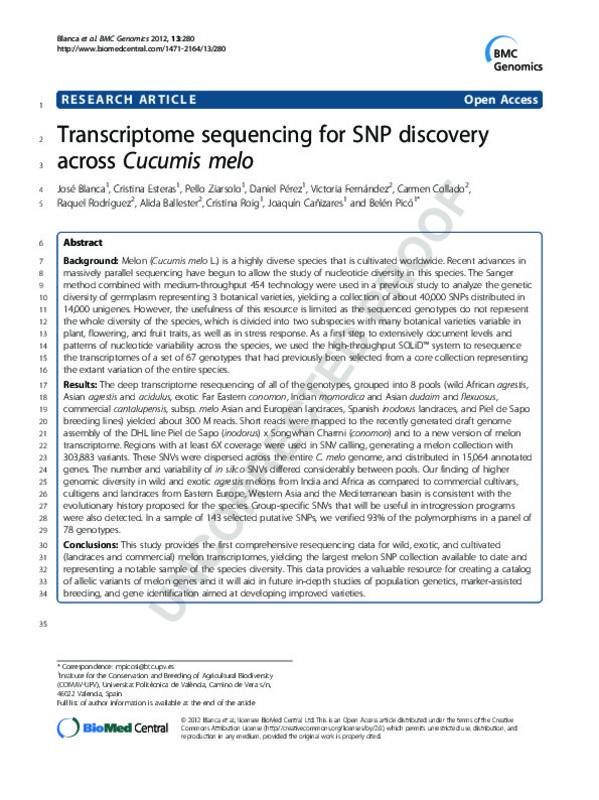|
Resumen:
|
Background: Melon (Cucumis melo L.) is a highly diverse species that is cultivated worldwide. Recent advances in massively parallel sequencing have begun to allow the study of nucleotide diversity in this species. The ...[+]
Background: Melon (Cucumis melo L.) is a highly diverse species that is cultivated worldwide. Recent advances in massively parallel sequencing have begun to allow the study of nucleotide diversity in this species. The Sanger method combined with medium-throughput 454 technology were used in a previous study to analyze the genetic diversity of germplasm representing 3 botanical varieties, yielding a collection of about 40,000 SNPs distributed in 14,000 unigenes. However, the usefulness of this resource is limited as the sequenced genotypes do not represent the whole diversity of the species, which is divided into two subspecies with many botanical varieties variable in plant, flowering, and fruit traits, as well as in stress response. As a first step to extensively document levels and patterns of nucleotide variability across the species, we used the high-throughput SOLiD¿ system to resequence the transcriptomes of a set of 67 genotypes that had previously been selected from a core collection representing the extant variation of the entire species.Results: The deep transcriptome resequencing of all of the genotypes, grouped into 8 pools (wild African agrestis, Asian agrestis and acidulus, exotic Far Eastern conomon, Indian momordica and Asian dudaim and flexuosus, commercial cantalupensis, subsp. melo Asian and European landraces, Spanish inodorus landraces, and Piel de Sapo breeding lines) yielded about 300 M reads. Short reads were mapped to the recently generated draft genome assembly of the DHL line Piel de Sapo (inodorus) x Songwhan Charmi (conomon) and to a new version of melon transcriptome. Regions with at least 6X coverage were used in SNV calling, generating a melon collection with 303,883 variants. These SNVs were dispersed across the entire C. melo genome, and distributed in 15,064 annotated genes. The number and variability of in silico SNVs differed considerably between pools. Our finding of higher genomic diversity in wild and exotic agrestis melons from India and Africa as compared to commercial cultivars, cultigens and landraces from Eastern Europe, Western Asia and the Mediterranean basin is consistent with the evolutionary history proposed for the species. Group-specific SNVs that will be useful in introgression programs were also detected. In a sample of 143 selected putative SNPs, we verified 93% of the polymorphisms in a panel of 78 genotypes.Conclusions: This study provides the first comprehensive resequencing data for wild, exotic, and cultivated (landraces and commercial) melon transcriptomes, yielding the largest melon SNP collection available to date and representing a notable sample of the species diversity. This data provides a valuable resource for creating a catalog of allelic variants of melon genes and it will aid in future in-depth studies of population genetics, marker-assisted breeding, and gene identification aimed at developing improved varieties. © 2012 Blanca et al.; licensee BioMed Central Ltd.
[-]
|









